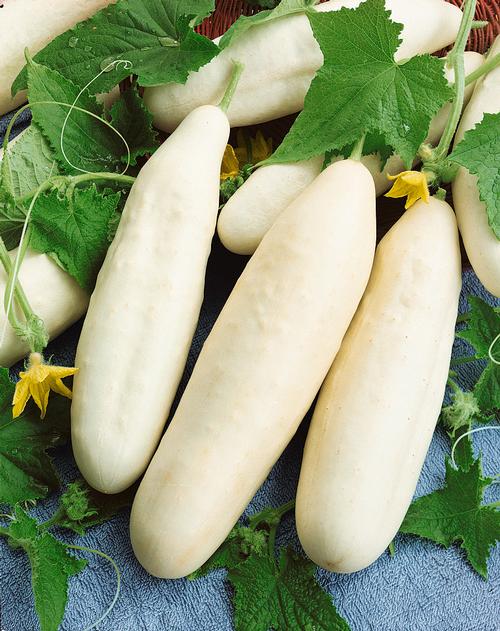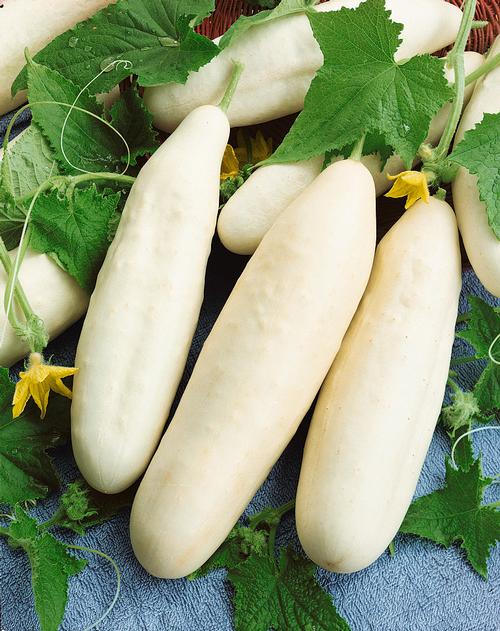White Wonder Cucumber
White Wonder Cucumber
Regular price
$2.95 USD
Regular price
Sale price
$2.95 USD
Unit price
per
Shipping calculated at checkout.
Couldn't load pickup availability
White Wonder
60 days — 'White Wonder' cucumber fruit are normally harvested at five to six inches long when their skin is a nice, white color. Although light colored or "white" cucumbers are now uncommon in the North American marketplace, they were once quite popular as a slicing and pickling variety.'White Wonder' is very old cucumber that has been listed over the years under several synonyms. These include, 'Albino', 'Ivory King', 'Jack Frost', 'Landreth's White Slicing', and 'White Albino'.[1] However, the origination of this variety was the W. Atlee Burpee Seed Company. They explained that their source was sent to them "... in the spring of 1890 ... from a customer in Western New York." The customer included a note saying, "The cucumbers are white from the time they begin to grow, and are the best I have ever seen, either for eating fresh or pickling."[3] and they subsequently introduced it for the 1893 gardening season.[1,2,3] Each packet contains one gram, which is approximately 25 to 30 seeds.

Planting Instructions: Cucumbers grow best with long, hot, humid days with maximum sunshine and warm nights. Plants are extremely susceptible to frost. Sow seeds outside only after danger of frost when soil has warmed. Make a second sowing 4 to 5 weeks later for a late summer or early fall harvest. For an earlier harvest and to reduce the threat of insect damage to seedlings, start a few plants indoors in individual pots (or trays with separate compartments) about a month before your last spring frost date.
Sowing: To seed in rows, plant seeds 1 inch deep and about 6 inches apart. To plant in hills, plant four or five seeds in 1-foot-diameter circles set 5 to 6 feet apart. Although the name or description of this variety refers to a modern company's name, the seed we are offering is in no way sourced from, "owned by" or connected with that company. The name is simply the historically accurate, common name for the variety giving credit to the seedsmen that originally released it.
Sowing: To seed in rows, plant seeds 1 inch deep and about 6 inches apart. To plant in hills, plant four or five seeds in 1-foot-diameter circles set 5 to 6 feet apart. Although the name or description of this variety refers to a modern company's name, the seed we are offering is in no way sourced from, "owned by" or connected with that company. The name is simply the historically accurate, common name for the variety giving credit to the seedsmen that originally released it.
Information References:
- "Vegetable Cultivar Descriptions for North America - Cucumber (S-Z), Lists 1-27 Combined," Edited by Todd C. Wehner, Department of Horticulture, North Carolina State University, Raleigh, North Carolina.
- "Vegetables of New York - Vol. 1 Part IV - The Cucurbits" - New York Agricultural Experiment Station, 1937.
- "Burpee's Farm Annual," W. Atlee Burpee & Co., 1893.
Explore our vegetable collections:
[ Artichokes | Asparagus | Beans | Beets | Broccoli | Sorghums | Brussels Sprouts | Cabbage | Cantaloupe | Carrots | Cauliflower | Celery | Collard Greens | Corn | Cucumber | Eggplant | Endives | Gourds | Kale | Kohlrabi | Leeks | Lettuce | Mesclun Mix | Mustard Greens | Okra | Onions | Parsley | Edible Pod Peas | Garden Peas | South Peas | Hot Peppers | Mild Peppers | Pumpkins | Radishes | Rapini | Rhubarb | Salad Greens | Salsify | Summer Squash | Winter Squash | Swiss Chard | Tomatillo | Tomatoes | Dwarf Tomato Project | Turnips | Watermelons ]

